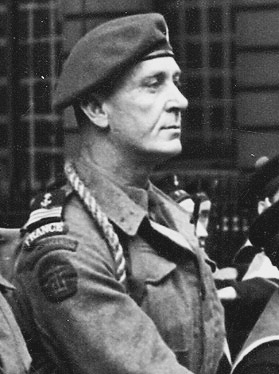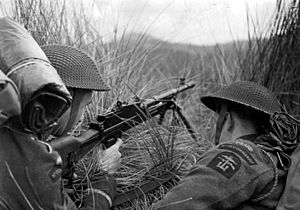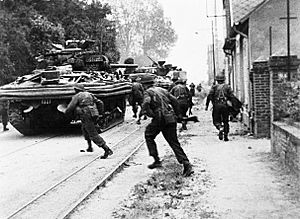No. 10 (Inter-Allied) Commando facts for kids
Quick facts for kids No. 10 (Inter-Allied) Commando |
|
|---|---|
 |
|
| Active | 1942–1945 |
| Country | |
| Branch | |
| Type | Commando |
| Role | Amphibious warfare Close-quarters combat Coastal raiding Cold-weather warfare Direct action Forward observer Raiding Reconnaissance Urban warfare |
| Size | Maximum 11 Troops |
| Part of | Combined Operations 1 Special Service Brigade |
| Garrison/HQ | Eastbourne |
| Engagements | Second World War |
| Disbanded | 4 September 1945 |
| Commanders | |
| Notable commanders |
Dudley Lister Peter Laycock |
| Insignia | |
| Combined Operations recognition badge | 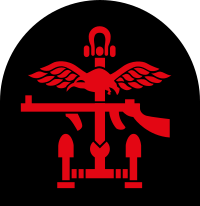 |
No. 10 (Inter-Allied) Commando was a special unit of the British Army during the Second World War. It was made up mostly of soldiers from countries in Europe that Germany had taken over. This unit helped the Allies work together during attacks.
The idea for this unit started in 1940, but it didn't get enough volunteers at first. In July 1942, it was created again as a team of many nations. Volunteers came from France, Belgium, the Netherlands, Norway, Denmark, Poland, and Yugoslavia. These soldiers were put into smaller groups called "troops."
No. 10 (Inter-Allied) Commando served in many places, including Europe, the Mediterranean Sea, Scandinavia, and Burma. Its troops often worked in small groups with other military units. By the end of the war, it had become the largest commando unit in the British Army.
What are Commandos?
"Commando" units were first formed in 1940. The British Prime Minister, Winston Churchill, wanted small, highly trained groups. Their job was to carry out quick raids along enemy coastlines.
At first, they were a small force of volunteers. They did small attacks on areas controlled by the enemy. By 1943, their role changed. They became lightly armed infantry (foot soldiers) who led landings from the sea.
Admiral Sir Roger Keyes was chosen to lead the commando force. By March 1941, there were 11 commando units, each about the size of a battalion. Each unit had about 390 men, divided into six "troops."
The idea for a commando unit made of foreign soldiers came from a French naval officer, Philippe Kieffer. He suggested it after a successful raid called Lofoten. Admiral Lord Louis Mountbatten, who was in charge of Combined Operations, liked the idea. He said it should include volunteers from all the occupied countries. This new unit would be part of the 1st Special Service Brigade.
Forming the Unit
No. 10 (Inter-Allied) Commando was officially formed on July 2, 1942. Lieutenant Colonel Dudley Lister was its first commander. All the men in the new commando were foreigners, except for the British officers and staff at the headquarters.
The headquarters staff included a British commander, a second-in-command, and officers for intelligence, medical care, and training. They also had signal and administration teams. This setup helped No. 10 Commando become the largest commando unit in the British Army by the end of the war.
Like all British Commandos, the men of No. 10 (Inter-Allied) Commando went through tough training. This six-week course was held at Achnacarry in the Scottish Highlands. It focused on being very fit, fast marches, weapon skills, map reading, climbing, and using small boats. They also learned how to use explosives day and night.
In May 1943, the commando moved to Eastbourne on the Sussex coast. Here, they did special training. This included parachute training, which was unusual for a unit that didn't jump from planes often. More than 80% of the Polish troop learned to parachute. They also trained in mountain climbing and fighting in cold, Arctic conditions. On May 15, Lieutenant Colonel Peter Laycock took over as the new commanding officer.
No. 1 (French) Troop
No. 1 Troop was formed in April 1942 by Philippe Kieffer. It started with 40 Frenchmen. This unit kept its ties with the Free French Forces. They wore their own special badges and hats. This troop, along with No. 8 Troop and a smaller "K-Gun" troop, worked with No. 4 Commando during the D-Day landings and the campaign in the Netherlands.
No. 2 (Dutch) Troop
No. 2 Troop had 62 men led by Captain Mulders. This troop was formed in June 1942. It was never at full strength and never fought as a complete unit on its own. The men from this troop often worked as guides and translators. They helped during operations like Market Garden and Infatuate.
About 48 men from the Royal Brigade "Princess Irene" started commando training in March 1942. In May 1942, they went to the main training center in Achnacarry, Scotland. Only 25 of them earned the green beret. After training, they moved to RAF Dundonald at Troon for more specialized training. Later, they went to Portmadoc in North Wales, where they officially became No. 2 (Dutch) Troop.
In May 1943, No. 2 Dutch Troop had five officers and 79 other ranks. Later in 1943, this troop was sent to Asia to fight the Japanese. Only five Dutchmen were sent to Burma, where they worked behind enemy lines with other commando units. After the war, members of this troop helped form the modern Dutch commando unit.
No. 3 Troop ("X" Troop)
No. 3 Troop, also known as "X" Troop, was a very unique unit. Most of its members were German and Austrian Jews. They were technically considered "enemy aliens" by the British. The troop also included German political refugees and members of other groups persecuted by the Nazis. Some members had even been held in concentration camps like Dachau and Buchenwald concentration camp.
All members of X Troop used British names and made up false personal histories to protect themselves and their families. About 130 men served in X Troop. They never fought as a full unit. Instead, they were very helpful to other military groups as translators and people who questioned prisoners. Sadly, 21 men from this troop were killed, and 22 were wounded.
This troop's secret existence was first revealed in a book in 1980. It showed how important they were, especially in gathering information. For example, during the Dieppe raid in 1942, five members of X Troop were ordered to get important German documents. Some even believe the whole large military operation was a cover to get a German code machine called Enigma.
No. 4 (Belgian) Troop
No. 4 Troop was formed on August 7, 1942. It had seven officers and 100 men from the 1st Independent Belgian Brigade. Because Belgium had surrendered in 1940, these Belgian soldiers risked being charged with treason if they returned home. These charges were only removed in 1948. After the war, this Belgian troop became the main part of the new 2nd Commando Battalion.
No. 5 (Norwegian) Troop
No. 5 Troop was formed in August 1942. It was led by Captain Rolv Hauge. The 120 men in this troop were refugees who had been brought to Britain after commando raids. Others were sailors who were stuck abroad after Germany invaded Norway.
No. 6 (Polish) Troop
No. 6 Troop was first formed in August 1942 as the 1st Independent Commando Company. It joined No. 10 Commando in October 1942. Led by Captain Smrokowski, it had seven officers and 84 men. These men were sometimes asked personally to join the unit.
No. 7 (Mediterranean) Troop
No. 7 Troop was formed in May 1943. It was created because there was a need for Italian speakers. However, it was hard to find Italian speakers in the British Army. So, the Special Operations Executive offered Slovenes (from Yugoslavia) who spoke Italian. This troop only had two officers and 20 men. It was later renamed No. 7 Yugoslavian Troop.
No. 8 (French) Troop
No. 8 Troop was formed in 1943. It had 45 men from a disbanded naval unit that had been in Lebanon. It also included men who had been held in Spain and then released. The two French troops (No. 1 and No. 8) were combined under Kieffer's command. They were called the 1er Bataillon de Fusiliers Marins Commandos (1st Naval Rifles Commando Battalion). The commander of No. 8 Troop, Captain Charles Trepel, was killed in action with five of his men during a scouting mission on the Dutch coast in February 1944.
Commando Operations
The soldiers from No. 10 (Inter-Allied) Commando usually worked with other units. Their knowledge of local areas and languages was very useful. They often acted as translators and questioned enemy prisoners.
1942 Actions
The first major action for men from the Commando was the Raid on Dieppe (Operation Jubilee) on August 19, 1942. Men from No. 3 ("British") Troop were supposed to collect German documents from the town hall. They also gave French money to the local French resistance. No. 1 (French) Troop worked with No.3 and No. 4 Commando. They helped translate, gather information, and encourage Frenchmen to join the Free French forces. The men with No. 4 Commando helped capture the Hess gun battery.
Many men from No. 3 Commando were captured during the landings. From No. 10 Commando / No. 3 Troop, one man was killed and two were captured and never seen again. Among the captured Frenchmen from No. 10 Commando / No. 7 Troop, Sergeant Major Montailleur was executed. However, Corporal Cesar managed to convince the Germans he was a French Canadian. He later escaped and returned to England.
1943 Actions
In early 1943, No. 5 Norwegian Troop worked with No. 12 and No. 14 Commando. They raided the Norwegian coast from their base in the Shetland Islands. No. 3 Troop was involved in the Sicily landings (Operation Husky). They worked with No. 40 (Royal Marine) Commando and No. 41 (Royal Marine) Commando. Later, they also took part in landings on mainland Italy.
Starting in July, the two French troops and No. 3 Troop carried out raids on the French and Low Countries coastlines. These raids, code-named Operation Forfar, Hardtack, and Operation Tarbrush, were for scouting beaches. Their goal was to get photos and examples of mines and obstacles. In one of these raids, Lieutenant George Lane was captured and questioned by Field Marshal Erwin Rommel. Lane believed he was not executed because of this meeting. In total, 12 men went missing during the Hardtack raids, and only five were later found.
In November, No. 4 Belgian and No. 6 Polish Troops joined the 2nd Special Service Brigade in Italy. The Polish troops famously captured a German-held village on their own. Later that year, No. 2 Dutch Troop was sent to Asia. They worked with No. 44 (Royal Marine) Commando and No. 5 Commando behind Japanese lines in Burma.
1944 Actions
In January 1944, the Belgian No. 4 Troop and the Yugoslav No. 7 Troop went to the Adriatic Sea. They were to help the Yugoslav Partisans. However, due to disagreements, the Yugoslav troop was disbanded. No. 4 Troop then worked with Vis Motor Gun Boats, boarding enemy ships. In April 1944, No. 6 Polish Troop was transferred to the II Polish Corps. They later took part in the Polish attack on Monte Cassino.
By the time of the D-Day landings, the commando had lost its Yugoslav and Polish troops. The two French troops worked with No. 4 Commando and landed on Sword Beach. No. 3 Troop was split up, with sections joining the other eight commando units involved in the landings.
The French troops, with 185 men, landed on the left side of Sword Beach. Only 144 reached their meeting point inland. Their goal was the Riva Bella Casino in Ouistreham. The lightly armed French commandos couldn't break into the strong building. They called for a tank from the Royal Marines Armoured Support Group, and soon captured the position. In another area, Corporal Peter Masters of No. 3 Troop was ordered to walk down a street in a deserted village. The idea was to draw enemy fire and find where the Germans were hiding.
By the night of D-Day, the 1st Special Service Brigade, including parts of No. 10 (Inter-Allied) Commando, had crossed the River Orne. They dug in to guard the left side of the 6th Airborne Division.
For the next three months, No. 3 Troop did patrols ahead of the British lines. These patrols were dangerous. The troop commander, Captain Bryan Hilton-Jones, was captured while trying to lead resistance fighters through the lines. Some captured men became prisoners of war, while others were never heard from again. Hilton-Jones was later freed by No. 46 (Royal Marine) Commando.
By the time the Allies reached the River Seine, only 40 of the original 185 French troops were unwounded. New men quickly joined the French ranks. These men had started training as a new No. 7 French Troop.
In mid-1944, No. 2 Dutch Troop returned to Europe. Their first mission was Operation Market Garden on September 17, 1944. The troop was divided among three parachute divisions.
The Belgian No. 4 Troop returned to England in June. They were chosen to capture the French island of Yeu. But during a scouting mission, they found the Germans had already left. They then moved to mainland Europe. They joined the 4th Commando Brigade for the attack on the island of Walcheren (Operation Infatuate).
The attack on Walcheren had the largest number of No. 10 (Inter-Allied) Commando men together since 1943. Under Lieutenant Colonel Laycock, the commando was spread out. Headquarters and parts of No. 3 Troop and No. 2 Dutch Troop worked with the 4th Commando Brigade. The French No. 2 and No. 8 troops, with part of No. 2 Dutch Troop, worked with No. 4 Commando. No. 4 Belgian and No. 5 Norwegian Troops worked with No. 41 (Royal Marine) Commando. In December, the new No. 7 French Troop joined the other two French Troops.
1945 Actions
From January to March, the three French troops raided the island of Schouwen-Duiveland. This was to stop the Germans from using the island to attack Antwerp.
In February, the Norwegian High Command asked for No. 5 Norwegian Troop to help free Norway. The troop was transferred to the Norwegian Army in late April. They were flown to Sweden dressed as civilians. They joined the Free Norwegian Brigade, ready to cross the border if the German soldiers refused to surrender.
The next big operation for men from No. 10 (Inter-Allied) Commando was crossing the River Rhine (Operation Plunder). Then they crossed the River Weser. The main commando force was the 1st Commando Brigade, with German-speaking men from No. 3 (X) Troop helping them.
Also in 1945, two new Belgian troops completed commando training. They formed No. 9 and No. 10 Troops. Along with No. 4 Troop, they helped provide local security. No. 10 Belgian Troop went on to help free the Neuengamme concentration camp.
What Happened Next
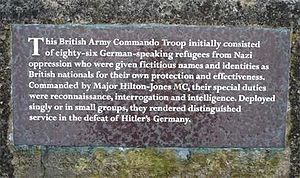
No. 10 (Inter-Allied) Commando was officially ended on September 4, 1945, after the war finished. However, many members of No. 3 Troop continued to do important secret work. They tracked down Nazi resistance groups and war criminals. They also translated captured documents.
At the same time, other Army Commandos were also ended. The special commando role was taken over by the Royal Marines. However, today's Parachute Regiment, Special Air Service, and Special Boat Service all have roots in the original Army Commandos.
Of the Western countries that had troops in No. 10 (Inter-Allied) Commando, only Norway did not create its own commando force later. The French troops are the ancestors of the French Naval Commandos. The Dutch Troop led to the Korps Commandotroepen. And the Belgian Troops are the forerunners of the Belgian Paracommando Brigade.
Battle Honors
The following honors were given to the British Commandos during the Second World War for their bravery in battles:
- Adriatic
- Alethangyaw
- Aller
- Anzio
- Argenta Gap
- Burma 1943–45
- Crete
- Dieppe
- Dives Crossing
- Djebel Choucha
- Flushing
- Greece 1944–45
- Italy 1943–45
- Kangaw
- Landing at Porto San Venere
- Landing in Sicily
- Leese
- Litani
- Madagascar
- Middle East 1941, 1942, 1944
- Monte Ornito
- Myebon
- Normandy Landing
- North Africa 1941–43
- North-West Europe 1942, 1944–1945
- Norway 1941
- Pursuit to Messina
- Rhine
- St. Nazaire
- Salerno
- Sedjenane 1
- Sicily 1943
- Steamroller Farm
- Syria 1941
- Termoli
- Vaagso
- Valli di Comacchio
- Westkapelle


